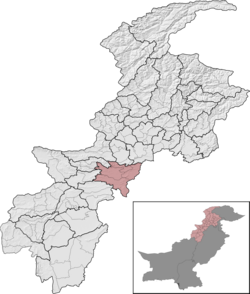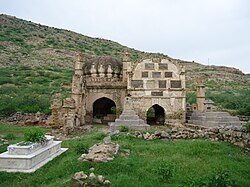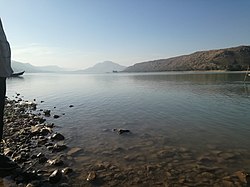Kohat District
Kohat District
ضلع کوہاٹ کوهاټ ولسوالۍ | |
|---|---|
 Kohat District (red) in Khyber Pakhtunkhwa | |
| Country | Pakistan |
| Province | Khyber Pakhtunkhwa |
| Division | Kohat |
| Headquarters | Kohat |
| Government | |
| • Type | District Administration |
| • Deputy Commissioner | Roshan Mehsud |
| • District Police Officer | N/A |
| • District Health Officer | N/A |
| Area | |
| 2,991 km2 (1,155 sq mi) | |
| Population (2023)[1] | |
| 1,234,661 | |
| • Density | 410/km2 (1,100/sq mi) |
| • Urban | 278,741 |
| • Rural | 955,920 |
| Time zone | UTC+5 (PST) |
| Number of Tehsils | 4 |
| Website | kohat |
Kohat District (Pashto: کوهاټ ولسوالۍ, Urdu: ضلع کوہاٹ) is a district in the Kohat Division of the Khyber Pakhtunkhwa province of Pakistan. Kohat city is its district capital.
History
[edit]Mughal era
[edit]From the early sixteenth century, the history of Kohat revolves around three major tribes namely Bangash, Banoori, and Afridi. These people seemingly established their settlements within the district during the 14th and 15th centuries. From 16th to 18th centuries, Kohat being the part of Mughal Empire was administered by the chiefs of the two aforementioned tribes.
Demography
[edit]| Year | Pop. | ±% p.a. |
|---|---|---|
| 1961 | 209,817 | — |
| 1972 | 308,507 | +3.57% |
| 1981 | 383,862 | +2.46% |
| 1998 | 651,100 | +3.16% |
| 2017 | 1,111,266 | +2.85% |
| 2023 | 1,234,661 | +1.77% |
| Sources:[2] | ||
As of the 2023 census, Kohat district has 169,679 households and a population of 1,234,661. The district has a sex ratio of 104.05 males to 100 females and a literacy rate of 58.55%: 76.38% for males and 40.28% for females. 334,178 (27.07% of the surveyed population) are under 10 years of age. 278,741 (22.58%) live in urban areas.[1]
At the time of the 2023 census, 85.90% of the population spoke Pashto, 12.43% Hindko, and 0.83% Urdu as their first language.[3]
Religion
[edit]| Religion | 1941[5]: 22 [a] | 2017[6] | 2023[4] | |||
|---|---|---|---|---|---|---|
| Pop. | % | Pop. | % | Pop. | % | |
| Islam |
100,868 | 88.01% | 1,106,709 | 99.59% | 1,228,271 | 99.49% |
| Hinduism |
9,156 | 7.99% | 1,004 | 0.09% | 609 | 0.05% |
| Sikhism |
3,613 | 3.15% | 71 | 0.01% | 106 | 0.01% |
| Christianity |
596 | 0.52% | 3,190 | 0.29% | 5,464 | 0.44% |
| Others | 383 | 0.33% | 292 | 0.02% | 129 | 0.01% |
| Total Population | 114,616 | 100% | 1,111,266 | 100% | 1,234,579 | 100% |
| Religious group |
1881[7] | 1891[8] | 1901[9] | 1911[10] | 1921[11] | 1931[12] | 1941[13] | |||||||
|---|---|---|---|---|---|---|---|---|---|---|---|---|---|---|
| Pop. | % | Pop. | % | Pop. | % | Pop. | % | Pop. | % | Pop. | % | Pop. | % | |
| Islam |
169,219 | 93.21% | 187,661 | 92.36% | 199,722 | 91.67% | 208,868 | 93.79% | 197,496 | 92.23% | 218,445 | 92.45% | 266,224 | 91.99% |
| Hinduism |
9,828 | 5.41% | 10,791 | 5.31% | 14,480 | 6.65% | 10,848 | 4.87% | 12,879 | 6.01% | 13,393 | 5.67% | 17,527 | 6.06% |
| Sikhism |
2,240 | 1.23% | 4,474 | 2.2% | 3,344 | 1.53% | 2,739 | 1.23% | 2,674 | 1.25% | 3,249 | 1.38% | 4,349 | 1.5% |
| Christianity |
212 | 0.12% | 197 | 0.1% | 317 | 0.15% | 222 | 0.1% | 1,074 | 0.5% | 1,186 | 0.5% | 1,304 | 0.45% |
| Jainism |
41 | 0.02% | 50 | 0.02% | 0 | 0% | 0 | 0% | 0 | 0% | 0 | 0% | 0 | 0% |
| Zoroastrianism |
0 | 0% | 0 | 0% | 0 | 0% | 0 | 0% | 0 | 0% | 0 | 0% | 0 | 0% |
| Buddhism |
0 | 0% | 0 | 0% | 0 | 0% | 0 | 0% | 0 | 0% | 0 | 0% | 0 | 0% |
| Judaism |
— | — | 0 | 0% | 2 | 0% | 13 | 0.01% | 0 | 0% | 0 | 0% | 0 | 0% |
| Others | 0 | 0% | 2 | 0% | 0 | 0% | 0 | 0% | 0 | 0% | 0 | 0% | 0 | 0% |
| Total population | 181,540 | 100% | 203,175 | 100% | 217,865 | 100% | 222,690 | 100% | 214,123 | 100% | 236,273 | 100% | 289,404 | 100% |
| Note: British North-West Frontier Province era district borders are not an exact match in the present-day due to various bifurcations to district borders — which since created new districts — throughout the region during the post-independence era that have taken into account population increases. | ||||||||||||||
Administration
[edit]Kohat district is divided into four Tehsils:
- Kohat (Urdu: تحصیل کوہاٹ)(Pashto: کوهاټ تحصیل)[14]
- Lachi (Urdu: تحصیل لاچی)(Pashto: لاچي تحصیل)
- Gumbat (Urdu: تحصیل گمبٹ)(Pashto: ګمبټ تحصیل)
- Dara Adam Khel Tehsil (Urdu: تحصیل درہ آدم خیل)(Pashto: دره ادم خېل تحصیل)
- formerly Frontier Region Kohat (Urdu: سرحدی علاقہ کوہاٹ)(Pashto: کوهاټ سرحدي سیمه)
Provincial Assembly
[edit]| Member of Provincial Assembly | Party Affiliation | Constituency | Year |
|---|---|---|---|
| Amjad Khan Afridi | Independent | PK-80 Kohat-I | 2018 |
| Shah Dad Khan | Muttahida Majlis-e-Amal | PK-81 Kohat-II | 2018 |
| Zia Ullah Khan Bangash | Pakistan Tehreek-e-Insaf | PK-82 Kohat-III | 2018 |
Notes
[edit]- ^ Figures are for Kohat tehsil of Kohat district, which roughly corresponds to the present district excluding erstwhile Frontier Region Kohat.
References
[edit]- ^ a b "7th Population and Housing Census - Detailed Results: Table 1" (PDF). www.pbscensus.gov.pk. Pakistan Bureau of Statistics. Archived (PDF) from the original on 26 July 2024. Retrieved 1 August 2024.
- ^ "Population by administrative units 1951-1998" (PDF). Pakistan Bureau of Statistics. Archived (PDF) from the original on 5 June 2023. Retrieved 3 August 2023.
- ^ a b "7th Population and Housing Census - Detailed Results: Table 11" (PDF). Pakistan Bureau of Statistics. Archived (PDF) from the original on 19 August 2024. Retrieved 1 August 2024.
- ^ a b "7th Population and Housing Census - Detailed Results: Table 9" (PDF). Pakistan Bureau of Statistics. Archived (PDF) from the original on 19 August 2024. Retrieved 1 August 2024.
- ^ "CENSUS OF INDIA, 1941 VOLUME X NORTH-WEST FRONTIER PROVINCE". Archived from the original on 11 October 2022. Retrieved 14 October 2021.
- ^ "Pakistan Census 2017 District-Wise Tables: Hangu". Pakistan Bureau of Statistics. Archived from the original on 18 August 2024.
- ^ "Census of India, 1881 Report on the Census of the Panjáb Taken on the 17th of February 1881, vol. II". 1881. p. 17. JSTOR saoa.crl.25057657. Archived from the original on 15 January 2024. Retrieved 16 June 2024.
- ^ "The Punjab and its feudatories, part II--Imperial Tables and Supplementary Returns for the British Territory". 1891. p. 14. JSTOR saoa.crl.25318669. Archived from the original on 9 January 2024. Retrieved 22 June 2024.
- ^ "Census of India 1901. [Vol. 17A]. Imperial tables, I-VIII, X-XV, XVII and XVIII for the Punjab, with the native states under the political control of the Punjab Government, and for the North-west Frontier Province". 1901. p. 34. JSTOR saoa.crl.25363739. Archived from the original on 28 January 2024. Retrieved 25 February 2024.
- ^ "Census of India 1911. Vol. 13, North-west Frontier Province : part I, Report; part II, Tables". 1911. p. 306. JSTOR saoa.crl.25394102. Retrieved 23 September 2021.
- ^ "Census of India 1921. Vol. 14, North-west Frontier Province : part I, Report; part II, Tables". 1921. p. 344. JSTOR saoa.crl.25430163. Archived from the original on 12 February 2023. Retrieved 2 February 2023.
- ^ Mallam, G. L.; Dundas, A. D. F. (1933). "Census of India, 1931, vol. XV. North-west frontier province. Part I-Report. Part II-Tables". Peshawar, Printed by the manager, Government stationery and printing, 1933. p. 373. JSTOR saoa.crl.25793233. Archived from the original on 8 February 2023. Retrieved 7 February 2023.
- ^ "Census of India, 1941. Vol. 10, North-West Frontier Province". 1941. p. 22. JSTOR saoa.crl.28215543. Archived from the original on 29 January 2023. Retrieved 23 September 2021.
- ^ "Tehsils & Unions in the District of Kohat". National Reconstruction Bureau (NRB), Government of Pakistan website. Archived from the original on 26 March 2012. Retrieved 26 October 2023.
Bibliography
[edit]- 1981 District Census report of Kohat. Vol. 27. Islamabad: Population Census Organization, Statistics Division, Government of Pakistan. 1983.
- 1998 District Census report of Kohat. Census publication. Vol. 42. Islamabad: Population Census Organization, Statistics Division, Government of Pakistan. 1999.
- Shackle, Christopher (1980). "Hindko in Kohat and Peshawar". Bulletin of the School of Oriental and African Studies. 43 (3): 482–510. doi:10.1017/S0041977X00137401. ISSN 0041-977X. S2CID 129436200.



